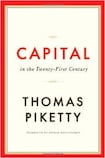
We all recall Ernest Hemingway's retort to F Scott FitzGerald's observation that the very rich "are different from you and me". "Yes. They have more money." Exactly how much more they have was not clear, because, before the research of Thomas Piketty and his collaborators over the past 15 years, economists were not terribly concerned with the distribution of income and wealth.
This unconcern comes as a surprise to noneconomists: after all, income distribution seems like a major issue in an economy, just like unemployment, growth and government deficits. And income distribution was the major preoccupation of the early economists Adam Smith, David Ricardo and Karl Marx.
But in the late 19th century economists came to view economic growth as the universal solvent for problems of economic distribution. An annual growth rate of 3 per cent, the sort experienced in prosperous economies in the decades after the second World War, meant that everyone’s income would double in 25 years. The poor of one generation would have a standard of living enjoyed by the middle class of their parents’ generation. A rising tide lifted all boats.

That this was starting to go wrong was evident from the late 1970s, as growth of western economies slowed rapidly, and a large share of what growth did occur went to the wealthy, leaving the middle classes and poor with a piece of pie that was barely growing.
Piketty and his collaborator Emmanuel Saez used income-tax records to look at the share of the very wealthy in national income since the first World War. Their findings were sobering. From the second World War until 1980 the top 10 per cent of American earners received a third of national income, with the top 1 per cent receiving a 10th. By 2007 the top 10 per cent were receiving half of national income and the top 1 per cent nearly a quarter.
These are levels of inequality not seen since the Roaring Twenties, although the identity of the rich has changed. Whereas most wealth was inherited in the 1920s, most high incomes now are earned by the “working rich”: managers of large corporations, particularly in finance.
Inequality surge
This jump in inequality is not the result of technological progress creating demands for the skills of superstars at the expense of the less talented. While the income share of top earners in the UK and Canada has risen almost as much as in the United States, their share of Japanese and continental European income has remained pretty fixed.
In Ireland Brian Nolan, my colleague at University College Dublin, finds that the share of the top 1 per cent fell from about 12 per cent before the second World War, to 6 per cent in the 1970s, and has risen to 8 per cent since 1990. In other words, we resemble the European pattern more than the Anglo-Saxon one.
Although the amount of data on income and wealth presented in Capital in the Twenty-First Century makes it an extraordinary work of scholarship, the interpretations that Piketty offers for changing income distribution are problematic.
In his earlier work with Saez, Piketty gave a central role to taxation, and therefore politics, in explaining why the income share of the rich fell during and after the second World War, and subsequently rose. The case of Switzerland is particularly instructive. Alone among industrialised economies, it did not impose heavy taxes on the rich after the second World War, with the result that their share of Swiss income remained at its 1920s level.
The big problem with Capital in the Twenty-First Century starts when Piketty goes from describing the distribution of income and wealth to attempting to explain it. His explanation centres on the fact that the return on capital, which measures how fast the wealth of the rich increases, is nearly always higher than the growth rate at which ordinary incomes rise, so the fundamental dynamic of capitalism is towards higher inequality and a greater role for inherited wealth.
However, in common with previous efforts to explain the entire dynamics of human history in a single line, Piketty's theory is not entirely successful. To see this we need to look at the world before the first World War, what Piketty describes as "patrimonial capitalism". Although the central concern of the book is that western society will return to this world centred on inherited wealth, beyond synopses of Mansfield Park and Père Goriot Piketty is pretty vague about the olden days, in particular how inequality changed in the 19th century.
If Piketty's story about slow growth leading inevitably to rising inequality and the power of the rich is true, then we expect that inequality would have risen sharply during the 19th century when growth in industrialised economies was less than 1 per cent per year. In fact the longstanding research of Peter Lindert and Jeffrey Williamson on English inequality (which Piketty, incredibly, fails to cite) finds inequality was fairly constant, albeit high, until about 1870, and then appears to have fallen somewhat until 1913.
Distracting focus
Piketty's focus on an imagined patrimonial capitalism is not only historically baseless but also distracts him from analysing the changes in Ronald Reagan's United States and Margaret Thatcher's Britain that led the very rich to start flexing their political muscle again at the expense of the lower orders.
Piketty ends with a dutiful few chapters on how a capital tax or high income taxes on the very rich might fix things while being too much of a realist to think they would ever work. Oddly, while some of his most startling findings are on the large magnitude of inheritance flows (for France, he calculates that annual bequests are equivalent to 15 per cent of annual national income) he devotes little attention to estate taxes. These have largely disappeared in most industrialised economies (although not in Ireland) but would seem to offer a way to raise large amounts of revenue at the expense of small numbers of undeserving heirs.












